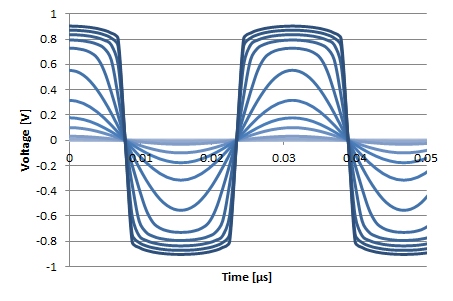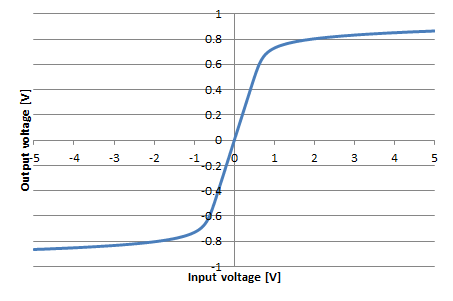Not possible in analog circuitry.
You could sum a low level (phase locked) 3kHz sine with a 1kHz sine.to synthesize such a case.
Otherwise to get the general flavor of the sound, just listen to a square wave. But it has additional
odd harmonics, at amplitudes related to 1/f.
You could sum a low level (phase locked) 3kHz sine with a 1kHz sine.to synthesize such a case.
Otherwise to get the general flavor of the sound, just listen to a square wave. But it has additional
odd harmonics, at amplitudes related to 1/f.
Last edited:
You didn’t explain use case.
For a test signal REW can produce signal with desired mix of harmonics or just single harmonic.

For a test signal REW can produce signal with desired mix of harmonics or just single harmonic.
Output from one branch of a long tail pair will have predominantly odd harmonics. Content of higher order harmonics will depend on the type of active elements and degeneration resistors. I suppose JFets without degeneration would be close to what you are looking for.
I'd be looking for an analogue circuit able to produce ONLY h3 from signal input in the audio range .If it's not possible, it's impossible...
Pass has an easy-to-read essay:
https://www.passdiy.com/project/articles/audio-distortion-and-feedback
I like his quip:
"IM distortion is the elephant on the dance floor."
You can make all these pretty bent sines, but as soon as you have multi-tone instruments or multiple instruments, you have IM products everywhere like the hair of my hairy house-dog.
https://www.passdiy.com/project/articles/audio-distortion-and-feedback
I like his quip:
"IM distortion is the elephant on the dance floor."
You can make all these pretty bent sines, but as soon as you have multi-tone instruments or multiple instruments, you have IM products everywhere like the hair of my hairy house-dog.
If I take it literally, you also don't want a fundamental, only pure distortion. Is that correct?
Nothing is perfect, especially not when it is analogue, but I would build some translinear circuit with bipolar transistor arrays. It can be quite straightforward if the fundamental doesn't need to be suppressed.
Nothing is perfect, especially not when it is analogue, but I would build some translinear circuit with bipolar transistor arrays. It can be quite straightforward if the fundamental doesn't need to be suppressed.
Indeed, I can accept the fundamental .Is there a circuit that can produce only the fundamental and H3?If I take it literally, you also don't want a fundamental, only pure distortion. Is that correct?
Nothing is perfect, especially not when it is analogue, but I would build some translinear circuit with bipolar transistor arrays. It can be quite straightforward if the fundamental doesn't need to be suppressed.
I can accept tiny amounts of the other harmonics as long as they are below -50...80db or inaudible in a normal musical program.
I'll draw a translinear circuit for you that ideally should do what you want. I haven't a clue how well it works in real life.
Square waves are composed of odd harmonics. So clipping a sinewave will approximate a square wave. Triangle waves are also composed of odd harmonics, but the higher order harmonics are reduced relative to square waves. So passing a sinewave through a slew rate limit might start to approximate triangle waves. I imagine passing the sinewave through a clipper to produce a nearly square wave and then cascading that with a slew rate limit would get you some pretty nice triangle waves. A steep low pass of that triangle wave could eliminate the upper harmonics, leaving you with the fundamental and the third harmonic over some range of frequencies.
Last edited:
Just some experiments...What is the use of a H3 only signal, how will it be applied?
I put here most of my diy work...when it's done.I don't like spoilling my surprises 🙂
It's not a big secret...there are very few audio applications linked to h3 content...but I need to break an audiophile embargo that's lurking around for very long.
It's not a big secret...there are very few audio applications linked to h3 content...but I need to break an audiophile embargo that's lurking around for very long.
Basically what olsond said, if it´s for an experiment.
1) symmetrically clip a sinewave.
No need at all to get a sharp edge squarewave, just couple anti-parallel diodes clipping it to ground will be enough.
Top and bottom peaks will be quite rounded.
Different signal levels will look like:

This coming from a symmetrical diode clipper transfer function:

this guarantees lots of controlled odd harmonics but not an excess of high order nasty ones.
2) and now you lowpass it to death, say using 2 or 3 cascaded 18dB/oct filters, so fundamental and third pass relatively unhampered but higher harmonics are smashed.
I expect waveform to look like the raw diode clipped one, but more rounded shoulders.
3) this is easy and doable for single frequencies; now you pass complex signals such as "music" and all Hell breaks loose 😉
1) symmetrically clip a sinewave.
No need at all to get a sharp edge squarewave, just couple anti-parallel diodes clipping it to ground will be enough.
Top and bottom peaks will be quite rounded.
Different signal levels will look like:

This coming from a symmetrical diode clipper transfer function:

this guarantees lots of controlled odd harmonics but not an excess of high order nasty ones.
2) and now you lowpass it to death, say using 2 or 3 cascaded 18dB/oct filters, so fundamental and third pass relatively unhampered but higher harmonics are smashed.
I expect waveform to look like the raw diode clipped one, but more rounded shoulders.
3) this is easy and doable for single frequencies; now you pass complex signals such as "music" and all Hell breaks loose 😉
It got a bit more complicated than I hoped. I thought one could get away with just one single-quadrant third-power circuit, but you actually need two of them to prevent generation of even harmonics. Anyway, I really have to go to sleep, so I'll explain the idea behind it later.

Thank you @MarcelvdG! Never heard of bcm transistors.I see they are matched trz but I don't see them paired in your circuit so I assume i can use normal bc trz.Am I correct?
I really wait for the whole circuit ideas and explanations .
I just want to make a tape simulator .I started doing it a while back and abandoned that work that looked pretty interesting:
https://www.diyaudio.com/community/...-cheap-cd-players-enhancing-the-noise.332134/
I can't afford a Portico 5042 to study it unfortunately...and there were also tons of abandoned ideas and projects in my life...I have a feeling though that Portico only used a controlled hard driven coupled tapehead system and no h3 generation ...Driving a tapehead with an op-amp can lead to significant amounts of both h2 and h3, but i want to have that harmonic gate effect that tape has as the tapeheads themselves are allowing for passing signals up to hundreds of kilohertz.
I really wait for the whole circuit ideas and explanations .
I just want to make a tape simulator .I started doing it a while back and abandoned that work that looked pretty interesting:
https://www.diyaudio.com/community/...-cheap-cd-players-enhancing-the-noise.332134/
I can't afford a Portico 5042 to study it unfortunately...and there were also tons of abandoned ideas and projects in my life...I have a feeling though that Portico only used a controlled hard driven coupled tapehead system and no h3 generation ...Driving a tapehead with an op-amp can lead to significant amounts of both h2 and h3, but i want to have that harmonic gate effect that tape has as the tapeheads themselves are allowing for passing signals up to hundreds of kilohertz.
Last edited:
I might get similar output when i drive hard a tapehead system without the tape itself , but i can't still measure its harmonics.No soundcard input around for the moment...Basically what olsond said, if it´s for an experiment.
1) symmetrically clip a sinewave.
No need at all to get a sharp edge squarewave, just couple anti-parallel diodes clipping it to ground will be enough.
Top and bottom peaks will be quite rounded.
Different signal levels will look like:

This coming from a symmetrical diode clipper transfer function:

this guarantees lots of controlled odd harmonics but not an excess of high order nasty ones.
2) and now you lowpass it to death, say using 2 or 3 cascaded 18dB/oct filters, so fundamental and third pass relatively unhampered but higher harmonics are smashed.
I expect waveform to look like the raw diode clipped one, but more rounded shoulders.
3) this is easy and doable for single frequencies; now you pass complex signals such as "music" and all Hell breaks loose 😉
Single ended circuits with no feedback might push for more h2 in the tapehead though...
Last edited:
Yet op amps driving hard the record tapehead can act as both predominant h3 generator and higher harmonics gate when the magnetic core gets saturated...so maybe nothing else is needed...I'd like to have a clear cut vision though on this subject.I heard B&O used such a h3 generator to check their tape machines, but i have no ideea what they were actually checking...
- Home
- Source & Line
- Analogue Source
- Third harmonic generator